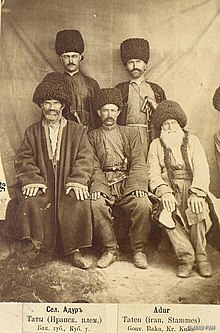
Back Tatz AN تاتيون Arabic Татал AV Tatlar Azerbaijani قافقاز تاتلاری AZB Таттар Bashkir Парси (Кавказ) Bulgarian Tati BS Tats Catalan Таташ CE
 1880 photograph depicting a group of Tat men from the village of Adur in the Kuba Uyezd of the Baku Governorate of the Russian Empire | |
| Total population | |
|---|---|
| tens of thousands (various estimates)[citation needed] | |
| Regions with significant populations | |
| 25,218 (2009)[1] | |
| 1,585 (2010)[citation needed] | |
| Languages | |
| Tat, Azerbaijani, and Russian | |
| Religion | |
| Islam | |
| Related ethnic groups | |
| Other Iranian peoples, Armeno-Tats | |
The Tat people (also: Tat, Parsi, Daghli, Lohijon) are an Iranian people presently living within Azerbaijan and Russia (mainly Southern Dagestan). The Tats are part of the indigenous peoples of Iranian origin in the Caucasus.[2][3][4]
Tats use the Tat language, a southwestern Iranian language somewhat different from Standard Persian,[5][6] as well as Azerbaijani and Russian. Tats are mainly Shia Muslims with a significant Sunni Muslim minority.
The 1886–1892 Tsarist population figures counted 124,683 Tats in the Russian Caucasus of which 118,165 were located in the Baku Governorate and 3,609 in the Dagestan Oblast.[7] The 1897 Russian Empire census recorded 95,056 Tats, of which 89,519 were in the Baku Governorate and 2,998 in the Dagestan Oblast.[7] The 1926 Soviet census only counted 28,705 Tats of which 28,443 were in the Azerbaijan SSR and 1,237 in the Dagestan ASSR.[7] Arthur Tsutsiev notes that a major portion of Tats in the 1926 census were listed under the categories "Persians" and "Azerbaijani Turks".[8] This was particularly the case within the Azerbaijan SSR, where some 38,327 individuals were recorded as "Turks whose native language is Tat".[9] The 1979 Soviet census counted 22,441 Tats of which 8,848 were located in the Azerbaijan SSR and 7,437 in the Dagestan ASSR.[7]
- ^ "Demography of Azerbaijan".
- ^ H. Pilkington,"Islam in Post-Soviet Russia", Psychology Press, Nov 27, 2002 . pg 27: "Among other indigenous peoples of Iranian origin were the Tats, the Talishes and the Kurds"[1]
- ^ R. Khanam,"Encyclopaedic Ethnography of Middle-East and Central Asia:P-Z, Volume 1", Global Vision Publishing Ho, 2005. pg 746:"The contemporary Tats are the descendants of an Iranian-speaking population sent out of Persia by the dynasty of the Sasanids in the fifth to sixth centuries."
- ^ T. M. Masti︠u︡gina, Lev Perepelkin, Vitaliĭ Vi͡a︡cheslavovich Naumkin, "An Ethnic History of Russia: Pre-Revolutionary Times to the Present", Greenwood Publishing Group, 1996. pg 80:"The Iranian Peoples (Ossetians, Tajiks, Tats, Mountain Judaists)" [2]
- ^ Gruenberg, Alexander. (1966). "Tatskij jazyk". In: Vinogradov, V. V. (ed.), Jazyki narodov SSSR. Volume 1: Indoevropejskie jazyki, 281-301. Excerpt: "The Tat language belongs to the Southwest group of Iranian languages and is close in its grammatical structure and lexical content to the Persian and Tajik languages."
- ^ Authier, Gilles (2012). Grammaire juhuri, ou judéo-tat, langue iranienne des Juifs du Caucase de l'est. Wiesbaden: Reichert. Excerpt: "Judaeo-Tat has no particular affinity with the Persian varieties, spoken until recently by Jews of Bukhara, Yazd, Isfahan, Kerman, Hamadan, Kashan, and Nahavand. Contrary to these, Judaeo-Tat is a different language that is not intelligible with Standard Persian;",
- ^ a b c d Tsutsiev, Arthur. "Appendix 3: Ethnic Composition of the Caucasus: Historical Population Statistics". Atlas of the Ethno-Political History of the Caucasus, New Haven: Yale University Press, 2014, p. 180.
- ^ Tsutsiev, Arthur. "Appendix 3: Ethnic Composition of the Caucasus: Historical Population Statistics". Atlas of the Ethno-Political History of the Caucasus, New Haven: Yale University Press, 2014, p. 189 (note 34).
- ^ Tsutsiev, Arthur. "Appendix 3: Ethnic Composition of the Caucasus: Historical Population Statistics". Atlas of the Ethno-Political History of the Caucasus, New Haven: Yale University Press, 2014, p. 189 (note 34).
© MMXXIII Rich X Search. We shall prevail. All rights reserved. Rich X Search